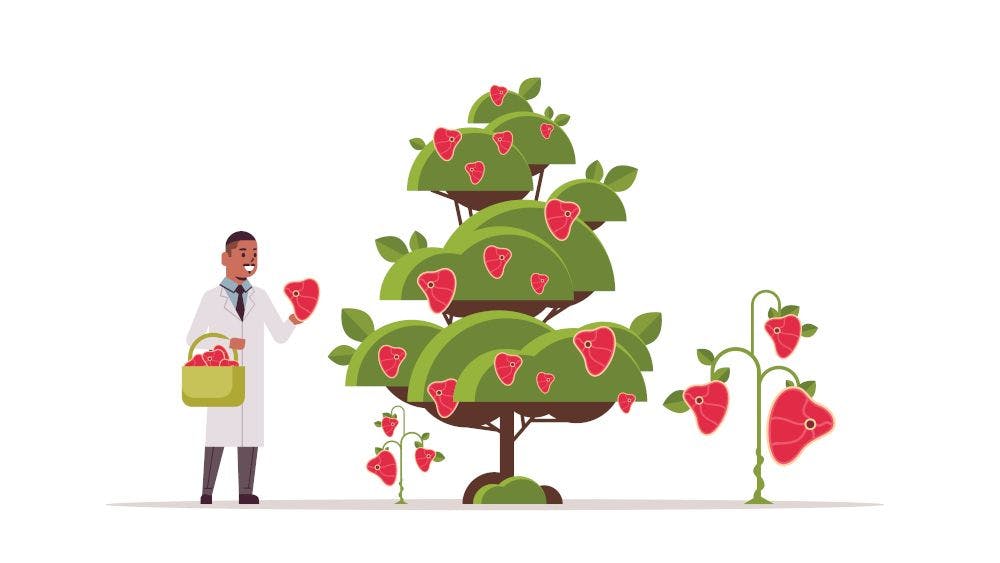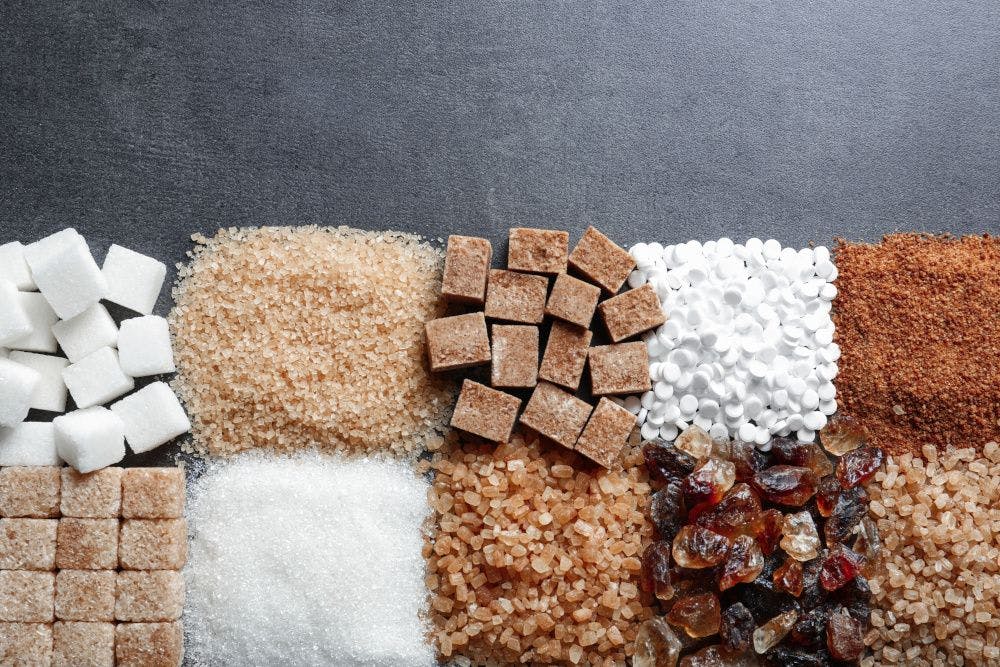Natural sweeteners: Business developments plus ingredient innovation means exciting times ahead
Natural-sweetener companies are hustling to make their ingredients friendlier to use.
Photo © New Africa - Stock.adobe.com

We’ve come a long way, baby, from when the grandaddy of sugar substitutes—saccharin—was first discovered in 1879. Saccharin wasn’t widely popularized until the 1950s when short-order cook Ben Eisenstadt and his son Marvin created Sweet’N Low tabletop sweeteners enveloped in the now-memorable pink packets. But saccharin’s journey was not an easy one, facing government bans, almost bans, and reversed bans, all due to alleged safety concerns. The artificial sweetener was joined in the market by its similarly controversy-coated competitors, including cyclamate (banned by FDA since 1969), aspartame, and sucralose, with others later joining the field.1,2
As consumers became more concerned with questions surrounding sugar substitutes and enamored with the notion of “natural” across a number of product categories, marketers became more savvy about pushing zero-calorie, reduced-sugar, clean-label claims specifically in the sweeteners market.
Today, sweetener solutions are led by the natural plant-based sweetener stevia (Stevia rebaudiana), which created an alternative to the sugar substitutes of yore. Not without its own controversies, including an initially rocky relationship with FDA seemingly resolved more than two decades ago, stevia has helped drive the surge of the natural-sweeteners category thanks to companies who continue to find ways to make stevia more appealing to consumers through technologies that expand applications, reduce sugar, and improve taste.
Other companies have also developed additional appealing natural solutions, notably those using monk fruit, natural cane, and beet sugar, for example.
A Sweet Spot for Natural-Sweetener Companies
According to Global Market Insights, a global market research and management consulting company, the global natural-sweeteners market is expected to reach $12.5 billion in five years, with a 4% CAGR between 2020 and 2026.3
“Governments continue to tighten regulations toward limiting sugar intake,” says Lorraine Niba, vice president of sales, North America, for Israel-based food-tech firm DouxMatok. “As a result, we’re seeing new companies entering the sugar-reduction playing field regularly as there is increased demand for solutions that can help food manufacturers reduce sugar in their formulations and ultimately limit sugar consumption at the consumer level.”
DouxMatok could be considered one of those newer companies. Cofounded in 2014 in Israel by a 96-year-old research chemist, the company started in R&D, working out of a subleased pharmaceutical research lab. But Professor Avraham Baneil was no run-of-the-mill research chemist, having spent 30 years as the managing director of Israel’s National Chemicals R&D Center, followed by his time as an industry consultant to leading sweetener ingredient companies such as ADM (Chicago), Cargill (Minneapolis), and Tate & Lyle (London). His cofounder was his son, Eran Baneil, now the company’s CEO. Today, DouxMatok is known as a global food-tech company on the move.
Fast-forward to 2020, when DouxMatok founded its flagship branded ingredient, Incredo Sugar, a real cane sugar product promising a 30%-50% reduction in sugar. Incredo Sugar earned a “Special Mention” on Time magazine’s list of “Best Inventions of 2020.”4
Niba, who joined DouxMatok from ingredients supplier Ingredion Inc. (Westchester, IL) in January of this year, explains, “Incredo Sugar spent years perfecting the commercialization of its sugar-based sugar-reduction solution, which is not a substitute, and we’re thrilled to now be talking with U.S. consumer packaged goods, foodservice, and emerging brands in the North American market about incorporating our solution into their products.”
SweeGen (Rancho Santa Margarita, CA) is another relatively recent entrant to the natural-sweeteners market, founded about a year prior to DouxMatok. Its website draws you in with mouthwatering photos demonstrating the what-could-be-options for its stevia-based ingredients, branded under the name Bestevia.
Casey McCormick, SweeGen’s director of product development, states that his company’s “ability to produce multiple [stevia] rebaudiosides with unique sensory profiles in the stevia plant is truly revolutionary in sugar reduction.” He adds, “The more rebaudiosides in our portfolio, such as Rebs B, D, E, I, M, and N, the more we can be innovative in collaborations with food and beverage manufacturers.”
In fact, late last year and earlier this year, SweeGen announced the expansion of its natural-sweetener portfolio with the commercial production of Bestevia Reb I and Reb N.5,6 The company announced that SweeGen has already received an FDA Generally Recognized as Safe (GRAS) “no objections” letter for its Reb I ingredient5 and Reb B.7
SweeGen is expanding its ingredients’ applications, having partnered with Blue California (Rancho Santa, CA) on a new line of beverage alcohol products that doubles down on two trends of interest to consumers: reducing the sugar while improving the flavor and adding functional ingredients. The new collection is called “Don’t Worry, Be Happy,” and, says McCormick, “SweeGen’s hallmark stevia sugar-reduction platform is the key to making the beverages zero- to low-sugar.”
He adds that “each of the nine beverages varies in alcohol beverage volume (ABV), from 5% to 35%, and includes 250 mg of Blue California Specialty Ingredients’ L-TeaActive L-theanine,” an amino acid thought to promote focus, aid in a healthy stress response, and support relaxation.
At the other end of the market, age-wise, are PureCircle and Cargill, both considered to be among the godparents of stevia sweeteners.
PureCircle was first incorporated in 2001, and since then the company has maintained a focused approach to its position as one of the leading producers and innovators in the global stevia market. An April 2020 press release announced an agreement that Ingredion Inc. would acquire a controlling 75% stake in PureCircle. The press release reassured customers that “Sugar reduction is one of Ingredion’s five specialities growth platforms, and Ingredion is committed to invest in growth. Stevia is a core product for the sugar-reduction portfolio.”6
The announcement not only reinforced PureCircle’s proud legacy in the stevia market but noted the intent is to expand that legacy by encouraging PureCircle to continue to bring “[its] unrivaled innovation and manufacturing expertise related to stevia.” In addition, said the press release, PureCircle will “leverage on Ingredion’s global go-to-market network, as well as its formulation expertise and broad product portfolio,” leading to “growth synergies as well as significant savings to both [PureCircle and Ingredion].”8
The deal was finalized last July9, and Andrea Carlson, head of commercial, PureCircle, says, “The results have been strong. Our customers are responding positively to our expanded sugar-reduction toolkit and the wider and deeper formulation expertise now available to them.”
Carlson explains that the deal was the biggest news in a 12-month period for PureCircle and also included channel-approach revisions and leadership alterations. And, she says, “What hasn’t changed is our commitment to bringing the best-tasting stevia ingredients to consumers by working with food and beverage companies to help create healthful, great-tasting foods and beverages.”
Cargill is a business giant, a leader in agricultural, food processing, and industrial products and services. In the sweeteners market, its website lists six broad categories: corn, polyol, specialty, sugar, and zero-calorie sweeteners as well as sugar-reduction solutions. Cargill’s specialty stevia sweeteners are branded under the names EverSweet, ViaTech, and Truvia. Cargill is recognized for bringing Reb A stevia natural sweetener to the beverage market thanks to its partnership with Coca-Cola in 2007. The ingredient launched in 2008, branded as Truvia, was touted by the company as the first natural, zero-calorie, great-tasting sweetener.10
Times and tastes have changed, yet Cargill has not wavered in its efforts to develop strong partnerships as well as stay on top of market trends.
To that end, in November 2019, the company announced a joint venture between Cargill and DSM known as Avansya.11 Carla Saunders, senior marketing manager for high-intensity sweeteners, Cargill, calls that joint venture a case of “bringing together two industry leaders to commercialize new technologies, pairing Cargill’s global footprint in sweeteners and large-scale fermentation capacity with DSM’s leading biotech know-how.”
She claims the immediate impact on the marketplace was huge. “We had a long line of customers interested in EverSweet. By partnering with DSM, we were able to bring out our first-of-its-kind, U.S.-based production facility online faster and deliver commercially viable quantities of EverSweet.”
Saunders notes that little more than a year later, “products sweetened with EverSweet are out in the marketplace, and brands are reimagining the possibilities for reduced-sugar products.” She looks forward to the partnership leading to more sweetener platforms and continued innovation.
Let’s Talk Taste
“The big driver today isn’t all that different than [when] we started this stevia journey more than a decade ago,” says Saunders. “It’s still all about taste.”
It’s hard to imagine anyone who would disagree that taste is not a key driver for this market. In fact, it may be the key differentiator between one ingredient and the next. As palates become more sophisticated, and an increasing number of consumers consider themselves foodies, taste can make or break even a natural-sweetener ingredient.
SweeGen’s McCormick references a December 2020 Mintel analysis that advised that 58% of U.S. consumers agree that taste is one of the top three important factors when purchasing food or drink.
But taste is complex.
Says McCormick, “Flavors and taste drive purchases across all categories. While the [stevia] rebaudiosides today continue to taste better than the old generation, it’s not enough to just replace sugar in food and beverages.”
McCormick refers to a “design thinking approach” in which he says you need to look at all elements of a product when reducing sugar. “Formulating with flavors for taste modification to balance out flavor and sweetness, or texturants to round out the mouthfeel, coupled with unique stevia and other nature-based sweeteners, is very important to the overall success of product formulations,” he states.
DouxMatok also views sugar reduction as going beyond an ingredient; rather, it is a system that creates a full solution to the taste problem. The company works with a sensory market research firm, a Nielsen subsidiary, to uncover consumer insights based on utilizing the five senses, not just taste. According to Niba, “We conduct external consumer sensory market research and daily sensory tests with a professional tasting panel.” Her takeaway from the research is “not only do we deliver the sweetness levels at 30%-50% reduction compared to traditional white sugar, but consumers actually prefer” products made with the company’s ingredient.
Over at Cargill, Saunders believes the taste gap between sugar and next-generation stevia products has dramatically narrowed.
“The original stevia products were based on a single sweet component, Reb A,” she says. “Those early products struggled with bitterness and linger issues, resulting in real limits on how much sugar you could pull out of a formula. Today, we know there are dozens of sweet compounds in the stevia leaf, and they taste very different by themselves and when used in combination. Our next-generation stevia products are light-years ahead of where we started. Formulators who dismissed stevia even five years ago would be well-served to give our latest stevia sweeteners a second look.”
What Else Do Companies and Consumers Value?
“In addition to taste,” notes Saunders, “the other areas that are increasingly important to our customers and their consumers center on sustainability and traceability.”
When it comes to Cargill’s sustainability program, Saunders is proud of how comprehensive it is. “It includes a detailed agricultural standard, designed to minimize the environmental impact of production practices, as well as ethical requirements that cover worker safety and welfare and prohibit the use of compulsory, convict, or child labor,” she says.
She shares that “every spring, we meet with our growers and review those standards. Every fall, we assure compliance through an independent audit. That attention to sustainable, ethical practices extends to our manufacturing facilities, which are also audited annually by independent third-party organizations.”
And, Saunders adds, “We combine that commitment with unparalleled traceability. Every lot of stevia we sell can be traced back through our supply chain to the farmers who planted the crop and the cooperative where it was grown. These are growers we know and fields we’ve walked.”
PureCircle’s Carlson also highlights the need for sustainability and traceability. She says, “We value sustainable and ethical ingredient sourcing, which is of the utmost importance to our customers. This is why PureCircle has significantly invested in a vertically integrated supply chain. We offer our customers full confidence, integrity, and transparency with our non-GMO stevia ingredients.”
Transparency counts for DouxMatok, too. Says Niba, “We are committed to being transparent with both consumers and potential partners. Any external communications, including Incredo Sugar’s website and social media channels, will focus on that pillar of transparency and education to ensure both individuals and businesses understand the benefits of sugar reduction in the immediate and long-term.”
And no one is discounting technology. SweeGen’s McCormick credits today’s advancements in technology as improving stevia ingredients even from just a few years ago. He says his company’s zero-calorie, non-GMO, nature-based stevia sweeteners are “produced by a proprietary bioconversion process, which enables incredible flexibility and diversity in the sweeteners we can produce.”
He adds that SweeGen’s enzymatic bioconversion of stevia maximizes the efficiency of crop yield, “so we are only producing the specific rebaudiosides that we need and not generating excess byproducts that could go to waste.”
And, of course, shoppers are always, always scrutinizing the product label itself—meaning the ingredient list matters. This is where natural sweeteners have a leg up. Carlson cites Ingredion’s Atlas proprietary research when advising that “consumers across the world continue to rank the ingredient list as the most important driver when selecting packaged foods and beverages, with sugar reduction being one of the most important claims. Plant-based solutions also continue to be preferable to artificial ones, with stevia leading the way.”
“Transparency in nutritional and ingredient labels,” says Carlson, “paired with public demand to reduce the amount of sugars, and preference for simple, plant-based sweeteners, has fueled innovation with stevia leaf ingredients.”
What’s Next for the Natural-Sweeteners Market?
“Natural sweeteners have gained in popularity as consumers continue to move away from artificial sweeteners,” says Cargill’s Saunders. “Almost two-thirds of global consumers (61%) say ‘no artificial sweeteners’ is an extremely or very important statement on food and beverage labels. Nearly a third (30%) say they’d pay more for products made without them.”12
As companies continue to uncover the different parts of the stevia leaf, combined with newer technology and tools, newer applications for sweeteners will follow.
Saunders advises, “Our journey with stevia is just beginning. There are more advances on the horizon, and they’re going to bring stevia to categories that previously weren’t able to fully tap into sugar reduction via natural sweeteners.”
She cites dairy as a great example. “Since we made it possible to access Reb M via our EverSweet stevia sweetener,” says Saunders, “the category has been on fire. As more tools and technology come online, tough applications like bakery may be the next space to discover stevia.”
PureCircle is eyeing many of the same categories. The company advises that being part of the Ingredion family provides the company with a “full portfolio offering taste and performance benefits for full sugar reductions in historically challenging categories for stevia, like bakery,” says Carlson.
She advises that “this year has shown us that consumers are increasingly interested in managing and understanding their own nutrition. Food and beverage companies will continuously look for ways to differentiate their products from the competition, and we anticipate that telling strong ingredient stories, like stevia’s natural origins, will be a vehicle for these brands to reach their consumers.”
According to DouxMatok’s Niba, her company’s team is already working with diverse sweet snack manufacturers, food service providers, fresh bakeries, chefs, and chocolatiers to incorporate Incredo Sugar in their products. The company currently works with various bakery partners in Israel who already make use of Incredo Sugar.
And DouxMatok is already making good on at least one of its 2021 goals: launching products with its branded ingredient in the U.S. and European markets.
In a press release promoting its introduction of Incredo Sugar to the U.S. market, DouxMatok announced its limited edition of Incredo Spreads, available for purchase on shop.incredosugar.com. The Spread the Happiness campaign gives American consumers an opportunity to “taste a product made with its innovative ingredient for the first time ever and experience the wonders of how sugar can be used to reduce sugar.”13
The limited consumer campaign features a consumer sweepstakes and a charitable donation to Common Threads, a nonprofit that provides children and families with the cooking and nutrition education to encourage healthy habits that contribute to wellness, according to the press release.13
What will natural-sweetener players need to do to keep their eye on the prize?
“On the horizon,” says SweeGen’s McCormick, “consumers will continue to demand great taste, lower sugar, and more nutrient-dense products. Natural flavors and modifying properties and functional ingredients will play a strong role in innovation.”
One thing is certain for this market category, and Saunders sums it up nicely: “The pressure to embrace sugar reduction shows no sign of easing. Consumer desire and government regulations will continue to push brands toward formulations with less sugar and fewer calories. It’s a huge challenge for the industry, but we are working hard to provide the tools and expertise necessary to help brands create the next generation of great-tasting, reduced-sugar products.”
For companies involved in this category, and consumers who reap the benefits, the natural-sweeteners market sounds like a sweet deal all around.
References
- “A Bitter ‘Sweet’ Family History.” All Things Considered program. National Public Radio. Aired May 21, 2006.
- Gershenson G. “A Brief and Bizarre History of Artificial Sweeteners.” Saveur. Published February 23, 2017.
- Press Release. “Natural Sweeteners Market to Hit $12.5 billion by 2026, Says Global Market Insights, Inc.” Global Market Insights. Issued November 17, 2020.
- “The Best Inventions of 2020—Sweetener Sugar—DouxMatok Incredo Sugar.” Time. Published November 19, 2020.
- Press release. “SweeGen Commercializes New Bestevia Reb I.” Issued October 28, 2020
- Press release. “SweeGen Announces Successful Scale-up of Bestevia Reb N.” Issued January 12, 2021.
- Marrapodi A. “SweeGen’s Reb B Stevia Ingredient Receives GRAS No Objection Letter from FDA.” Nutritional Outlook. Published online March 17, 2021.
- Press release. “Ingredion to Acquire Controlling 75% Stake in PureCircle.” Issued April 9, 2020.
- Press release. “Ingredion Completes Acquisition of PureCircle.” Issued July 1, 2020.
- “Cargill Introduces Truvia Natural Sweetener Brand, the First Natural, Zero-Calorie, Great-Tasting Sweetener.” NutritionInsight.com. Published May 16, 2008.
- Press release. “Cargill-DSM Joint Venture Avansya Starts Commercial-Scale Production of EverSweet Stevia Sweetener, as Consumers Increasingly Demand Reduced-Calorie Food and Beverages.” Issued November 14, 2019.
- HealthFocus International data, 2020
- Press Release. “DouxMatok Releases Unlimited Edition Incredo Spreads.” Issued April 20, 2021.

Prinova acquires Aplinova to further increase its footprint in Latin America
April 7th 2025Prinova has recently announced the acquisition of Brazilian ingredients distributor Aplinova, which is a provider of specialty ingredients for a range of market segments that include food, beverage, supplements, and personal care.




















